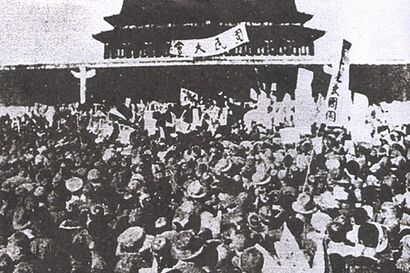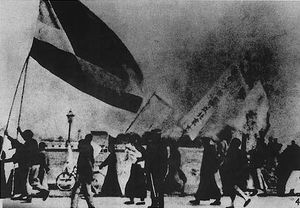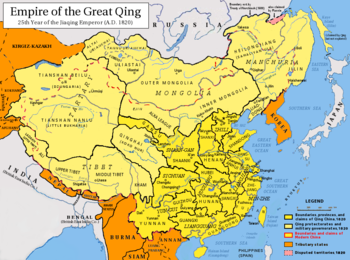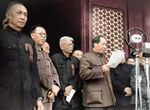حركة الرابع من مايو
| ||||||||||||||||||||||||||||||||||||||||||||||||||||||||||||||||||||||||||||||||||||||||||||||||||||||||||||||||||||||||||||||||||||||||||||||||||||||||||||||||||||||||||||||||||||||||||||||||||||||||||||||||||||||||||||||||||||||||||||||||||||||||||
| ||||||||||||||||||||||||||||||||||||||||||||||||||||||||||||||||||||||||||||||||||||||||||||||||||||||||||||||||||||||||||||||||||||||||||||||||||||||||||||||||||||||||||||||||||||||||||||||||||||||||||||||||||||||||||||||||||||||||||||||||||||||||||
| ||||||||||||||||||||||||||||||||||||||||||||||||||||||||||||||||||||||||||||||||||||||||||||||||||||||||||||||||||||||||||||||||||||||||||||||||||||||||||||||||||||||||||||||||||||||||||||||||||||||||||||||||||||||||||||||||||||||||||||||||||||||||||
حركة الرابع من مايو (الصينية: 五四运动; پنين: Wǔsì Yùndòng؛ إنگليزية: May Fourth Movement) كانت حركة ثقافية وسياسية مناهضة للإمبريالية نمت من الطلبة المشاركين في بكين في 4 مايو 1919، الذي كانوا يحتجون على ضعف رد الفعل الصيني على معاهدة ڤرساي، خاصة مع السماح لليابان بالحصول على أراضي في شاندونگ والتي حاصرتها ألمانيا بعد حصار تسينگتاو. أشعلت هذه المظهرات الاحتجاجات الوطنية وأدت إلى تأجج القومية الصينية، نحو التعبئة السياسية والابتعاد عن الأنشطة الثقافية، والتحرك نحو القاعدة الشعبوية بدلاً من النخبة الفكرية. في تلك الفترة، ظهر الكثير من القادة السياسيين والاجتماعيين في العقود التالية.
مظاهرات الرابع من مايو كانت نقطة تحول في حركة الثقافة الجديدة الأوسع والمناهضة للتقاليد (1915-1921) التي سعت إلى استبدال القيم الكونفوشية التقليدية، وكانت في حد ذاتها استمراراً لإصلاحات تشينگ المتأخرة. حتى بعد 1919، فإن ذلك "الشباب الجديد" عرّف دوره بنموذج تقليدي تضطلع فيه النخبة المتعلمة بالمسئولية في كلٍ من الشئون الثقافية والسياسية.[1] لقد عارضوا الثقافة التقليدية لكنهم بحثوا في الخارج عن الإلهام العالمي باسم القومية وكانوا حركة حضرية بأغلبية ساحقة اعتنقت الشعبوية في بلد ريفي بأغلبية ساحقة. ظهر العديد من القادة السياسيين والاجتماعيين في العقود الخمسة التالية في هذا الوقت، بمن فيهم قادة الحزب الشيوعي الصيني.[2]
خلفية
المناخ والمزاج السياسي الذي ظهر ح. 1919، "في كلمات ميتر (2004)"، كان يتركز في مجموعة من الأفكار التي صاغت القرن العشرين الهائل في الصين".[3] في أعقاب ثورة شينهاي عام 1911، انحلت أسرة تشينگ. كان هذا بمثابة نهاية للحكم الامبراطوري القوي الذي استمر لآلاف السنين، وبشر نظرياً لعصر جديد وقفت فيه السلطة مع الشعب. ومع ذلك، فالواقع هو أن الصين كانت دولة مجزأة يسيطر عليها أمراء الحرب، الذين لم يكونوا مهتمين سوا بسلطاتهم السياسية وجيوشهم الخاصة بدلاً من المصالح الوطنية.[4] كانت حكومة بييانگ منشغلة بقمع الشئون الداخلية ولم تفعل الكثير لمواجهة التأثير الذي تمارسه القوى الأجنبية.[5] حركة الواحد من مارس التي حدثت في كوريا (1919)، الثورة الروسية (1917)، الهزائم على يد القوى الأجنبية ووجود مناطق النفوذ أشعل الإحساس بالوطنية بين الطبقة الوسطى البازغة والزعماء المثقفين[بحاجة لمصدر]. زعماء الحركة الثقافية الجديدة كانوا يعتقدون بأن القيم الكونفشيوسية التقليدية كانت مسئولة عن الضعف السياسي للأمة[بحاجة لمصدر]. دعا الوطنيون الصينيون إلى رفض القيم التقليدية والتبني الاختياري للقيم الغربية "لسيد العلوم" (賽先生; 赛先生; sài xiānsheng) و"سيد. الديمقراطية" (德先生; dé xiānsheng) من أجل تعزيز الأمة الجديدة.[6] هذه الآراء والبرامج المتمردة والمناهضة للتقليدية صاغت سياسات وثقافة الصين حتى الوقت الحاضر.[7]
مشكلة شاندونگ
دخلت الصين الحرب العالمية الأولى على جانب الوفاق الثلاثي المتحالف عام 1917 بشرط رجوع جميع مناطق النفوذ الألمانية، مثل شاندونگ، إلى الصين. بالرغم من أنه في تلك السنة تم إرسال 140.000 عامل صيني إلى فرنسا (كجزء من الجيش البريطاني، [[فيلق العمال الصينيي])،[8] بموجب معاهدة ڤرساي، أبريل 1919 مُنحت اليابان الحقوق الألمانية في مقاطعة شاندونگ. قدم ممثلو الحكومة الصينية المطالب التالية:
- الغاء جميع امتيازات القوى الأجنبية في الصين، مثل extraterritoriality
- إلغاء "المطالب الإحدى وعشرون" مع اليابانيين
- استعادة الصين أراضي وحقوقها في شاندونگ، والتي كانت اليابان قد أخذتها من ألمانيا أثناء الحرب العالمية الأولى
سيطر الحلفاء على الاجتماع الذي عقد في ڤرساي، ولم يلتفتوا للمطالب الصينية. اهتمت بريطانيا وفرنسا بصفة أساسية في عقاب ألمانيا. بالرغم من ترويج الولايات المتحدة لنقاط وودرو ويلسون الأربعة عشر وقيم تقرير المصير، إلا أنهم لم يتمكنوا من الدفع بهذه المثل العليا في مواجهة المقاومة العنيفة من قبل ديڤيد لويد جورج، جورج كلمنصو، والكونگرس الأمريكي. الدفاع الأمريكي عن تقرير المصير في عصبة الأمم كان جذاباً بالنسبة للمفكرين الصينيين، لكن فشلهم في المضي قدماً كان ينظر إليه كخيانة. فشل الدبلوماسية الصينية في مؤتمر سلام باريس تسبب في اندلاع حركة الرابع من مايو، وأصبحت تعرف "بمشكلة شاندونگ".
أيام الاحتجاج
في صباح الرابع من مايو 1919، التقى ممثلو الطلبة من ثلاثة عشر جامعة محلية مختلفة في بكين وصدر عن اجتماعهم القرارات الخمس التالية:
- معارضة منح شاندونگ لليابانيين بموجب الامتيازات الألمانية السابقة.
- التوعية بالموقف الصيني الهش لدى الجماهير في الصين
- التوصية بتجمع حاشد في بكين
- الدفع لتأسيس اتحاد طلبة بكين
- عقد مظاهرة في مساء اليوم نفسه احتجاجاً على شروط معاهدة ڤرساي.
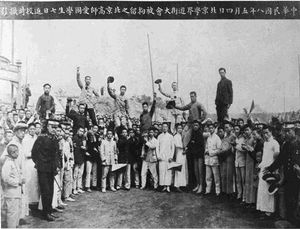
On the afternoon of May 4 over 4,000 students of Yenching University, Peking University and other schools marched from many points to gather in front of Tiananmen. They shouted such slogans as "struggle for the sovereignty externally, get rid of the national traitors at home", "do away with the Twenty-One Demands", and "don't sign the Versailles Treaty".
They voiced their anger at the Allied betrayal of China, denounced the government's spineless inability to protect Chinese interests, and called for a boycott of Japanese products. Demonstrators insisted on the resignation of three Chinese officials they accused of being collaborators with the Japanese. After burning the residences of these officials and beating some of their servants, student protesters were arrested, jailed, and severely beaten.[9]
The next day, students in Beijing as a whole went on strike and in the larger cities across China, students, patriotic merchants, and workers joined protests. The demonstrators skillfully appealed to the newspapers and sent representatives to carry the word across the country. From early June, workers and businessmen in Shanghai also went on strike as the center of the movement shifted from Beijing to Shanghai. Chancellors from thirteen universities arranged for the release of student prisoners, and Cai Yuanpei, the principal of Peking University resigned in protest.
Newspapers, magazines, citizen societies, and chambers of commerce offered support for the students. Merchants threatened to withhold tax payments if China's government remained obstinate.[10] In Shanghai, a general strike of merchants and workers nearly devastated the entire Chinese economy.[9] Under intense public pressure, the Beijing government released the arrested students and dismissed Cao Rulin, Zhang Zongxiang and Lu Zongyu that had been accused of being collaborators with the Japanese. Chinese representatives in Paris refused to sign the Versailles Treaty: the May Fourth Movement won an initial victory which was primarily symbolic, since Japan for the moment retained control of the Shandong Peninsula and the islands in the Pacific. Even the partial success of the movement exhibited the ability of China's social classes across the country to successfully collaborate given proper motivation and leadership.[9]
الأهمية التاريخية

| حركة الثقافة الجديدة |
|---|
|
|
Scholars rank the New Culture and May Fourth Movements as significant turning points, as David Wang said, "it was the turning point in China's search for literary modernity",[11] along with the abolition of the civil service system in 1905 and the overthrow of the monarchy in 1911. The challenge to traditional Chinese values, however, was also met with strong opposition, especially from the Nationalist Party. From their perspective, the movement destroyed the positive elements of Chinese tradition and placed a heavy emphasis on direct political actions and radical attitudes, characteristics associated with the emerging Chinese Communist Party (CCP). On the other hand, the CCP, whose two founders, Li Dazhao and Chen Duxiu, were leaders of the movement, viewed it more favorably, although remaining suspicious of the early phase which emphasized the role of enlightened intellectuals, not revolution.[12] In its broader sense, the May Fourth Movement led to the establishment of radical intellectuals who went on to mobilize peasants and workers into the CCP and gain the organizational strength that would solidify the success of the Chinese Communist Revolution.[10]
During the May 4th Movement, the group of intellectuals with communist ideas grew steadily, such as Chen Tanqiu, Zhou Enlai, Chen Duxiu, and others, who gradually appreciated Marxism's power. This promoted the sinicization of Marxism and provided a basis for the birth of the CCP and socialism with Chinese characteristics.[13]
مولد الشيوعية الصينية
| جزء من سلسلة عن |
| الثورة الشيوعية الصينية |
|---|
|
|
لعدة سنوات، كانت النظرة التقليدية في جمهورية الصين الشعبية بأنه بعد مظاهرات عام 1919 وقمعها، فإن القرار أصبح سياسياً أكثر فأكثر. تحول أشخاص مثل تشن دوشيو ولي داژاو إلى اتجاه أكثر يسارية وأصبحوا مؤسسين للحزب الشيوعي الصيني في 1921، بينما مفكرين آخرين، مثل الكاتب والداعية السياسي الأناركي با جين، أصبحوا أكثر تعاطفاً.[14]
في الأصل، الشخصيات الداعية للتطوعية أو للعدمية مثل لي شيتسن وژو تشيانژي قاموا باستدارات مشابهة إلى اليسار حيث شهدت الصين في العشرينيات اضطراباً متزايداً.[15]
وفي 1939، زعم القائد الأعلى للحزب الشيوعي ماو زىدونگ أن حركة الرابع من مايو كانت مرحلة تؤدي إلى تحقق الثورة الشيوعية الصينية.
The May Fourth Movement twenty years ago marked a new stage in China's bourgeois-democratic revolution against imperialism and feudalism. The cultural reform movement which grew out of the May Fourth Movement was only one of the manifestations of this revolution. With the growth and development of new social forces in that period, a powerful camp made its appearance in the bourgeois-democratic revolution, a camp consisting of the working class, the student masses and the new national bourgeoisie. Around the time of the May Fourth Movement, hundreds of thousands of students courageously took their place in the van. In these respects the May Fourth Movement went a step beyond the Revolution of 1911.[16]
Paul French argues that the only victor of the Treaty of Versailles in China was communism, as rising public anger led directly to the formation of the CCP. The Treaty also led to Japan pursuing its conquests with greater boldness, which Wellington Koo had predicted in 1919 would lead to the outbreak of war between China and Japan.[17]
Western-style liberal democracy had previously had a degree of traction amongst Chinese intellectuals. Still, after the Versailles Treaty (which was viewed as a betrayal of China's interests), it lost much of its attractiveness. Woodrow Wilson's Fourteen Points, despite being rooted in moralism, were also seen as Western-centric and hypocritical.[15]
Many Chinese intellectuals believed that the United States had done little to convince the other nations to adhere to the Fourteen Points and observed that the United States had declined to join the League of Nations. As a result, they turned away from the Western liberal democratic model. With victory of the Russian October Revolution in 1917, Marxism began to take hold in Chinese intellectual thought, particularly among those already on the Left. Chinese intellectuals such as Chen Duxiu and Li Dazhao began serious study of Marxist doctrine.[18]
الثقافية
The May Fourth Movement focused on opposing Confucian culture and promoting a new culture. As a continuation of the New Culture movement, the May Fourth Movement greatly influenced the cultural field. The slogans of "democracy" and "science" advocated in the New Culture Movement were designed to attack the old culture and promote the new culture. This purpose can be summed up in a sentence from David Wang: "It was the turning point in China's search for literary modernity."[11]
Participants at the time, such as Hu Shih, referred to this era as the Chinese Renaissance because there was an intense focus on science and experimentation.[19] In Chinese literature, the May Fourth Movement is regarded as the watershed after which the use of the vernacular language (baihua) gained currency over and eventually replaced the use of Literary Chinese in literary works. Intellectuals were driven toward expressing themselves using the spoken tongue under the slogan 我手寫我口 ('my hand writes [what] my mouth [speaks]'), although the change was actually gradual: Hu Shih had already argued for the use of the modern vernacular language in literature in his 1917 essay "Preliminary discussion on literary reform" (文學改良芻議), while the first short story written exclusively in the vernacular language, The True Story of Ah Q by Lu Xun, was not published until 1921.
More ordinary people also began to try to get in touch with new cultures and learn from foreign cultures. Joseph Chen said: "This intellectual ferment had already had an effect in altering the outlook of China's new youth.".[20] After the May Fourth Movement, the Chinese modern female literature developed a literature with modern humanistic spirit, taking women as the subject of experience, thinking, aesthetics, and speech.[بحاجة لمصدر]
Instead of the formerly euphemistic language for sex, May Fourth reformers used the broader, more explicit term, xing.[21]
In honor of the May Fourth Movement, May 4 is now celebrated as Youth Day in mainland China and as Literary Day in Taiwan.
الدبلوماسية
The first direct effect of the May Fourth Movement was to get the Beiyang government to refuse to sign contracts that were unfavorable to China.[بحاجة لمصدر]
الاقتصادية
During the movement, anger against Japan erupted because the Paris peace Treaty gave it the right to occupy the Shandong Peninsula. Many elements of society and joined students to publicize the boycott of Japanese products. The wave of a boycotts led to hopes that when Japanese products were suppressed, China's national industry would develop and promote the rapid development of China's national economy.[محل شك][بحاجة لمصدر]
النقد والمقاومة
Although the movement was highly influential, many of the intellectuals at the time opposed the anti-traditional message and many political figures ignored it. "this limited May Fourth individualist enlightenment did not lead the individual against the collective of the nation-state, as full-scale, modern Western individualism would potentially do.".[22]
Kuomintang leader Chiang Kai-shek, as a nationalist and Confucianist, was against the iconoclasm of the May Fourth Movement. As an anti-imperialist, he was skeptical of Western ideas and literature. He criticized these May Fourth intellectuals for corrupting the morals of youth.[23] When the Nationalist party came to power under Chiang's rule, it carried out the opposite agenda. The New Life Movement promoted Confucianism, and the Kuomintang purged China's education system of western ideas, introducing Confucianism into the curriculum. Textbooks, exams, degrees, and educational instructors were all controlled by the state, as were all universities.[24]
Some conservative philosophers and intellectuals opposed any change, but many more accepted or welcomed the challenge from the West but wanted to base new systems on Chinese values, not imported ones. These figures included Liang Shuming, Liu Shipei, Tao Xisheng, Xiong Shili, Zhang Binglin and Lu Xun's brother, Zhou Zuoren.[25] In later years, others developed critiques, including figures as diverse as Lin Yutang, Qian Mu, Xu Fuguan, and Yu Yingshi. Li Changzhi believed that the May Fourth Movement copied foreign culture and lost the essence of its own culture. (Ta Kung Pao, 1942). This is consistent with what Vera Schwarcz has said: "Critically-minded intellectuals were accused of eroding national self-confidence, or more simply, of not being Chinese enough."[26]
Chinese Muslims ignored the May Fourth movement by continuing to teach Classical Chinese and literature with the Qur'an and Arabic along with officially mandated contemporary subjects at the "Normal Islamic School of Wanxian".[27] Ha Decheng did a Classical Chinese translation of the Quran.[28] Arabic, vernacular Chinese, Classical Chinese and the Qur'an were taught in Ningxia Islamic schools funded by Muslim General Ma Fuxiang.[29]
التقليدية الجديدة مقابل الفكر الغربي
Although the May Fourth Movement did find partial success in removing traditional Chinese culture,[بحاجة لمصدر][30] there were still proponents who steadfastly argued that China's traditions and values should be the fundamental foundations of the nation. From these opponents of Western civilization derived three neotraditional schools of thought: national essence, national character, and modern relevance of Confucianism. Each school of thought denounced the western values of individualism, materialism and utilitarianism as inadequate avenues for the development of China. Each school held to specific objectives. The "national essence" school sought to discover aspects of traditional culture that could potentially serve the national development of China. Such traditional aspects consisted of various philosophical and religious practices that emerged parallel with Confucianism. Most particularly, China imported Buddhism, a religion from their neighboring countries, India and Nepal. Under the "national character" school, advocates promoted the traditional family system, the primary target of the May Fourth Movement. In this school, reformers viewed Westerners as shells without morals. Finally, the modern relevance of Confucianism was centered on the notion that Confucian values were better than Western ones. In response to western culture's primary concentration on rational analysis, China's neo-traditionalists argued that this was misguided, especially in the practical, changing milieu of the world. Most importantly, these three neo-traditionalist thoughts did not consider the individual, which was the main theme of the May Fourth Movement.[12]
انظر أيضاً
- "يوميات مجنون" تأليف لو شون
- تاريخ جمهورية الصين
- تاريخ بكين
- الثورة الثقافية
- حادثة تيينآنمن (حركة الخامس من أبريل 1976)
- احتجاجات ميدان تيينآنمن 1989
الهوامش
- ^ Schwarcz, Vera (1986). The Chinese Enlightenment: Intellectuals and the Legacy of the May Fourth Movement of 1919 (in الإنجليزية). University of California Press. pp. 9–11. ISBN 978-0-520-06837-7.
- ^ Hayford (2009), p. 569.
- ^ Mitter, R. A Bitter Revolution: China's Struggle with the Modern World (2004), p.12
- ^ Cambridge International AS Level International History 1871-1945 Coursebook, Phil Wadsworth, p. 109
- ^ Rana Mitter. A Bitter Revolution: China's Struggle with the Modern World. (Oxford; New York: Oxford University Press, 2004), p. 12.
- ^ Jonathan D. Spence. The Gate of Heavenly Peace: The Chinese and Their Revolution, 1895-1980. (New York: Viking Press, 1981), pp. 117-123 ff..
- ^ The Cambridge History of China. John King Fairbank, Denis Crispin Twitchett, p.451
- ^ Guoqi Xu. Strangers on the Western Front: Chinese Workers in the Great War. (Cambridge, Mass.: Harvard University Press, 2011. ISBN 9780674049994), pp. 1-9, and passim.
- ^ أ ب ت Wasserstrom, Jeffrey N. "Chinese Students and Anti-Japanese Protests, Past and Present". World Policy Journal. Archived from the original on November 5, 2013. Retrieved Nov 18, 2008.
- ^ أ ب Hao, Zhidong. "May 4th and June 4th Compared: A Sociological Study of Chinese Social Movements". Journal of Contemporary China. Retrieved 2008-11-21.
- ^ أ ب Wang, David Der-wei (2017-05-22). A New Literary History of Modern China (in الإنجليزية). Harvard University Press. p. 2. ISBN 978-0-674-97887-4.
- ^ أ ب Schoppa, R.Keith. Revolution and Its Past: Identities and Change in Modern Chinese History. Upper Saddle River, New Jersey: Pearson Prentice Hall. pp. 177–179.
- ^ Chan, Adrian (2003). Chinese Marxism. Continuum Publishing. ISBN 978-0826473073.
- ^ Patrick Fuliang Shan, “Li Dazhao and the Chinese Embracement of Communism,” in Shiping Hua (ed.), Chinese Ideology, Routledge, 2022, 94-110.
- ^ أ ب Lin, Yu-Kai; Mair, Victor H (2020). Remembering May Fourth: The Movement and its Centennial Legacy. Brill. pp. 58 & 114. ISBN 978-90-04-42488-3.
- ^ The May Fourth Movement (May 1939)
- ^ French, Paul (2016). Betrayal in Paris: How the Treaty of Versailles led to China's Long Revolution. Penguin. pp. 74–78.
- ^ Patrick Fuliang Shan, “Assessing Li Dazhao’s Role in the New Cultural Movement,” in A Century of Student Movements in China: The Mountain Movers, 1919-2019, Rowman Littlefield and Lexington Books, 2020, pp.3-22.
- ^ Hu Shih, The Chinese Renaissance: The Haskell Lectures, 1933. (Chicago: University of Chicago Press, 1934).
- ^ Chen, Joseph T. (1971). The May Fourth Movement in Shanghai: The Making of a Social Movement in Modern China (in الإنجليزية). BRILL. pp. 18–20. ISBN 978-90-04-02567-7.
- ^ Rodriguez, Sarah Mellors (2023). Reproductive realities in modern China : birth control and abortion, 1911-2021. Cambridge, United Kingdom: Cambridge University Press. ISBN 978-1-009-02733-5. OCLC 1366057905.
- ^ Chen, Xiaoming (2008-06-05). From the May Fourth Movement to Communist Revolution (in الإنجليزية). SUNY Press. p. 8. ISBN 978-0-7914-7986-5.
- ^ Joseph T. Chen (1971). The May fourth movement in Shanghai: the making of a social movement in modern China. Brill Archive. p. 13. Retrieved 2010-06-28.
- ^ Werner Draguhn, David S. G. Goodman (2002). China's communist revolutions: fifty years of the People's Republic of China. Psychology Press. p. 39. ISBN 0-7007-1630-0. Retrieved 2011-04-09.
- ^ Charlotte Furth, "Culture and Politics in Modern Chinese Conservatism," in Charlotte Furth, ed., The Limits of Change: Essays on Conservative Alternatives in Republican China. (Cambridge, Massachusetts: Harvard University Press, Harvard East Asian Series 84, 1976). ISBN 0674534239.
- ^ Schwarcz, Vera (1986). The Chinese Enlightenment: Intellectuals and the Legacy of the May Fourth Movement of 1919 (in الإنجليزية). University of California Press. pp. 9–11. ISBN 978-0-520-06837-7.
- ^ Stephane A. Dudoignon; Komatsu Hisao; Kosugi Yasushi (27 September 2006). Intellectuals in the Modern Islamic World: Transmission, Transformation and Communication. Routledge. pp. 251–. ISBN 978-1-134-20597-4.
- ^ Stephane A. Dudoignon; Komatsu Hisao; Kosugi Yasushi (27 September 2006). Intellectuals in the Modern Islamic World: Transmission, Transformation and Communication. Routledge. pp. 253–. ISBN 978-1-134-20597-4.
- ^ Stephane A. Dudoignon; Komatsu Hisao; Kosugi Yasushi (27 September 2006). Intellectuals in the Modern Islamic World: Transmission, Transformation and Communication. Routledge. pp. 256–. ISBN 978-1-134-20597-4.
- ^ Chow, Tse-tsung (2013). The May Fourth Movement: Intellectual Revolution in Modern China. Harvard University Press. p. 173. ISBN 978-0-674-28340-4.
المراجع
- Chow Tse-Tsung: The May Fourth Movement. Intellectual Revolution in Modern China (Cambridge/Mass.: Harvard University), 1960.
- Hao, Zhidong, "May 4th and June 4th Compared: A Sociological Study of Chinese Social Movements." Journal of Contemporary China 6.14 (1997): 79-99.
- Lee, Haiyan, "Tears that Crumbled the Great Wall: The Archaeology of Feeling in the May Fourth Folklore Movement." Journal of Asian Studies 64.1 (2005): 35-65.
- Ping, Liu, "The Left Wing Drama Movement in China and Its Relationship to Japan." Positions: East Asia Cultures Critique 14.2 (2006): 449-466.
- Schoppa, R. Keith, "Constructing a New Cultural Identity: The May Fourth Movement." Revolution and Its Past: Identities and Change in Modern Chinese History (Upper Saddle River, New Jersey: Pearson Prentice Hall), 2006, 162-180.
- Schwarcz, Vera: The Chinese enlightenment: intellectuals and the legacy of the May Fourth Movement of 1919 (1986). Berkeley: University of California Press.
- Spence, Jonathan D. The Search for Modern China. ISBN 0-393-30780-8 New York: Norton, 1999.
- Wasserstrom, Jeffrey N., "Chinese Students and Anti-Japanese Protests, Past and Present" World Policy Journal 22.2 (2005): 59-65.
- Zarrow, Peter, "Intellectuals, the Republic, and a new culture", in Zarrow, Peter: China in war and revolution, 1895-1949 (New York: Routledge), 2005, 133-143.
- Zarrow, Peter, "Politics and culture in the May Fourth Movement", in Zarrow, Peter: China in war and revolution, 1895-1949 (New York: Routledge), 2005, 149-169.
وصلات خارجية
- Columbia University, China: A Teaching Workbook — documents on May Fourth Movement
- May 4th 1919 Monument in Beijing — photos, directions, + background.
- Chinese Posters.net: "May Fourth Movement (1919)"
- Chinese Posters.net: "Propaganda, Politics, History, Art" (Amsterdam University) — mostly post 1949 posters, and commentary.
- Harv and Sfn no-target errors
- Short description is different from Wikidata
- Articles with hatnote templates targeting a nonexistent page
- Missing redirects
- Articles containing صينية-language text
- Articles containing traditional Chinese-language text
- Articles containing إنگليزية-language text
- Pages using Lang-xx templates
- Articles with unsourced statements from October 2016
- Articles containing simplified Chinese-language text
- Articles containing Chinese-language text
- Portal-inline template with redlinked portals
- Pages with empty portal template
- Articles with unsourced statements from May 2022
- مقالات ذات عبارات محل شك
- Articles with unsourced statements from April 2010
- احتجاجات في جمهورية الصين
- تاريخ بكين
- تاريخ جمهورية الصين
- 1919 في الصين
- تبعات الحرب العالمية الأولى
- الشيوعية في الصين
- العلاقات الصينية اليابانية
- جمهورية الصين (1912–49)
- عصر أمراء الحرب في جمهورية الصين
- نزاعات 1919
- ثورات 1917–23
